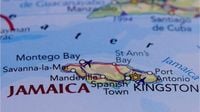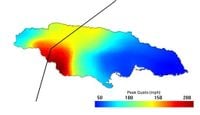In the aftermath of Hurricane Melissa, communities across Jamaica and Cuba are grappling with devastation on a scale rarely seen in the Caribbean. The storm, which made its first landfall in Jamaica on October 28, 2025, as a Category 5 hurricane with maximum sustained winds of 185 mph, has left a trail of destruction, staggering economic losses, and a rising human toll that experts warn may only be beginning to surface.
According to catastrophe modeling firms, insured property losses from Hurricane Melissa are estimated to fall between $1.5 billion and just over $4 billion. Cotality (formerly CoreLogic) reported that Jamaica alone faces insured losses ranging from $1 billion to $2.5 billion, while total property damage—including wind, storm surge, and flooding—may reach as high as $9 billion. These estimates, noted by Cotality, do not account for automobile infrastructure, offshore and inland marine, or losses sustained by other islands.
Verisk Extreme Event Evolutions placed their estimate for privately insured losses in Jamaica and Cuba between $2.2 billion and $4.2 billion, with the majority of damages attributed to wind. The high-resolution KCC Caribbean Hurricane Model projects a privately insured loss figure of $2.4 billion for both countries. For context, KCC points out that only the 2005 Atlantic hurricane season saw as many as three Category 5 hurricanes, underscoring the exceptional nature of this year's storms.
Hurricane Melissa's impact on Jamaica was particularly severe. The storm first struck New Hope in the western parish of St. Elizabeth, where its most brutal winds—clocked at 185 mph—leveled large swaths of the landscape. According to KCC data, over 75 percent of buildings in St. Elizabeth Parish were either damaged or destroyed, with some areas reporting catastrophic roof loss rates of 80 to 100 percent. Verisk noted that both non-engineered residential structures and engineered commercial buildings suffered similar levels of destruction. Montego Bay, in neighboring St. James Parish, experienced winds of 135 mph and significant damage to both homes and businesses, while Savanna-la-Mar in Westmoreland Parish endured 125 mph winds and widespread destruction, though somewhat less severe than in Black River.
Kingston, Jamaica's capital, was comparatively spared, experiencing only tropical storm-force winds and minimal damage. As a result, losses in the capital are expected to be relatively low. However, the storm's western eyewall devastated Jamaica's agricultural heartland in St. Elizabeth, destroying large egg and crop operations. According to KCC, this has fueled fears of staple food shortages and higher prices that could persist until at least February 2026.
Tourism, a vital pillar of Jamaica's economy, was not immune to Melissa's wrath. Montego Bay's renowned tourism corridor suffered extensive structural damage from wind, storm surge, and flooding. Sandals Resorts International, a major player in the sector, has announced plans to reopen five properties in early December, but three flagship resorts—Montego Bay, Royal Caribbean, and South Coast—will remain closed until May 30, 2026. This prolonged closure is expected to have ripple effects on employment and the broader tourism ecosystem in the region.
In Cuba, particularly in the eastern provinces, the destruction was also profound. KCC reports that approximately 10 percent of buildings in affected areas experienced total collapse, while more than 30 percent lost their roofs entirely. Over half of the remaining structures suffered moderate to severe roof damage, including loss of covering, deck separation, or framing failure. These figures highlight the vulnerability of building stock in the region, much of which is constructed with masonry walls but lightweight metal or zinc sheet roofs—often the weakest link during hurricanes.
One factor complicating recovery efforts is the low rate of insurance coverage across both Jamaica and Cuba. According to both Cotality and Verisk, household and small-business insurance penetration hovers between 5 and 20 percent, with many considered underinsured. Commercial and automobile lines are similarly exposed, while insurance coverage for large hotels, utilities, and airports is substantially higher, ranging from 80 to 100 percent. As a result, the insured impact is expected to be significantly less than the total economic impact, with reinsurers absorbing much of the payout due to local insurers ceding most of the risk.
The human toll, meanwhile, is still being counted. As of November 6, 2025, the official death toll from Hurricane Melissa in Jamaica stands at 32. This figure includes three fatalities that occurred during storm preparations, such as tree cutting and electrocution, which the National Hurricane Center (NHC) classifies as indirect deaths. The NHC distinguishes between direct deaths—those caused by the immediate forces of the tropical cyclone, like drowning or wind-induced injuries—and indirect deaths, which include accidents during storm preparation, heart attacks, house fires, and other incidents related to the broader impact of the storm.
However, as NBC6 and the Washington Post have reported, the true human cost of such disasters often takes years to emerge. In the aftermath of Hurricane Maria in Puerto Rico, the initial death toll was widely criticized as too low, prompting a government-commissioned study by George Washington University that found nearly 3,000 excess deaths in the six months following the storm. These excess deaths included fatalities from disrupted emergency services, lack of medical care, food insecurity, generator accidents, mold exposure, and mental health crises.
A 2024 study published in Nature revealed that excess deaths can continue to climb for up to 15 years after a major hurricane, with each event generating between 7,000 and 11,000 additional fatalities over that period. Given this context, many experts believe that the current reported death toll from Hurricane Melissa is only the beginning. "Sadly for Jamaica, I have every reason to believe that when accounting for direct and indirect fatalities as well as long-lasting morbidity and mental health impacts, the human toll reported so far from Hurricane Melissa is only the tip of the iceberg," wrote one commentator for NBC6.
With much of Jamaica and Cuba still reeling from the storm, the process of recovery promises to be long and arduous. Persistent protection gaps in insurance coverage, destruction of vital infrastructure, and the prospect of food shortages and economic hardship pose ongoing challenges. The lessons from past disasters like Hurricane Maria serve as a sobering reminder: the aftermath of a storm often lingers far longer than the winds and rain themselves.






